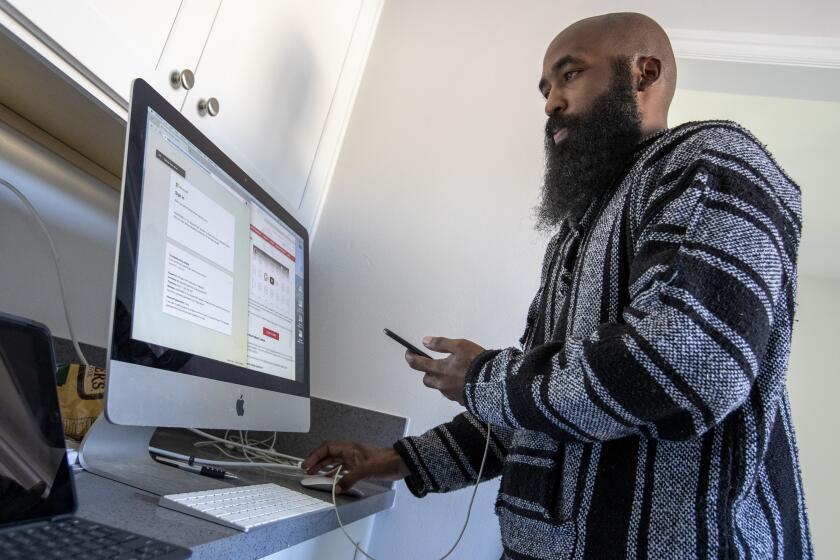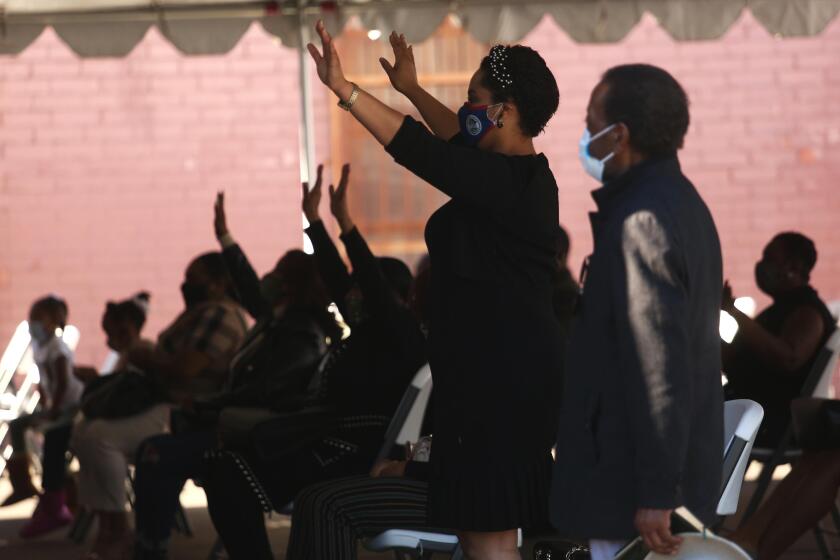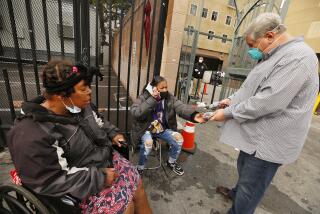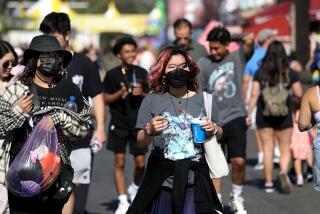Coronavirus hospitalizations surge to unprecedented level as L.A. announces stay-at-home rules

- Share via
The number of Californians hospitalized with the coronavirus surged to a record high for a fourth straight day — soaring above 8,000 amid continued concerns that a sustained spike in patients may eventually swamp the state’s healthcare system.
Though the 8,517 hospitalizations seen Tuesday are unprecedented, officials caution that it likely doesn’t represent the ceiling of the latest COVID-19 surge, as the figure largely excludes anyone who was only recently infected, including over the Thanksgiving weekend.
“We do have a choice to make, each one of us: Do we want to be part of the solution to this horrifying surge, or do we want to be the problem?” Los Angeles County Public Health Director Barbara Ferrer said during a briefing Wednesday. “Because where you fall in this effort now has a life-or-death consequence, possibly for people you know and love, but certainly for people across the county who are loved by others.”
Gov. Gavin Newsom sounded the alarm on the state of the state’s hospitals earlier this week. Unless things change, he said, California could exceed its existing intensive care unit capacity by mid-December, a possibility he warned could require dramatic action to keep from becoming reality.
On Wednesday night, the city of Los Angeles issued a modified stay-at-home order that conforms with an L.A. County order issued on Friday. The city order says residents should stay at home whenever possible and prohibits gatherings of people outside immediate households, with some exceptions such as religious services and protests.
While the order tells people to stay home, it also allows retail businesses to remain open “after implementing the County of Los Angeles Department of Public Health Protocols for Retail Establishments Opening for In-person Shopping.”
Parks and trails remain open along with golf courses, tennis courts, beaches. Music and television production is allowed.
“The city and county orders are the same. In the past there have been some minor differences but currently they are the same,” said Alex Comisar, a spokesman for Garcetti.
California averages 14,120 COVID cases a day with more than 8,200 hospitalized, both records, as state and local officials weigh lockdown measures.
Though ICU numbers have not yet reached the heights seen during the last COVID-19 surge over the summer, they are fast approaching those levels.
As of Tuesday — the most recent day for which state data are available — there were 2,006 COVID-19 patients in intensive care. That’s up roughly 75% from two weeks ago.
The state’s all-time record is 2,058, set on July 21.
Though hospitals have plans in place to expand their capacity should need arise, their ability to do so is limited. ICUs present a particular challenge because they typically need specialized space, equipment and staff.
“What matters is a hospital’s practical ability to take care of the patients that come in the door, and that requires not just a bed but, more importantly, it requires people, it requires staff, it requires supplies and equipment,” Dr. Christina Ghaly, L.A. County’s director of health services, said during a briefing.
With the number of patients rising rapidly, officials said they are increasingly concerned that demand could outpace the available supply — particularly in ICUs.
“Unless there has been and continues to be changes in community transmission, we do anticipate that we will have a shortage of ICU beds over the next four weeks,” Ghaly said of L.A. County. “Hospitals will have to take substantive action to meet the need for hospital and, particularly, for ICU level of care.”
Contact tracers tell people they’ve tested positive for the coronavirus or warn they’ve been exposed to it. The conversations are confidential and sometimes surprisingly intimate.
Despite the distressing statistics, the prospect of even more restrictions — which Newsom said could include some form of new stay-at-home order for areas in the strictest purple tier of the state’s coronavirus reopening road map — will be a tough sell for pandemic-battered businesses and rule-weary Californians.
L.A. County, for instance, has already run into opposition for recent steps it’s taken.
Most objectionable for many has been the renewed suspension of outdoor dining at restaurants — which officials said will help tamp down transmission by reducing lengthy interactions between largely unmasked patrons.
Critics, however, have derided the move as wholly unjustified by any kind of data and a capricious broadside against an already reeling industry.
Pasadena, which has its own city health department, has decided not to follow the county’s lead. The Beverly Hills City Council voted unanimously to oppose the outdoor dining ban Tuesday, and asked staff to research the idea of forming an independent public health department that would allow the city to set its own rules.
The South Bay Cities Council of Governments, a joint powers authority of 16 cities and parts of the county, recently sent a letter to Newsom asking that he “reconsider allowing significantly large areas that are less impacted by COVID cases and hospitalizations to have more local control over the restrictions on businesses in their area.”
“It is time to replace the ‘one-size-fits-all policies’ with an ability to adopt local restrictions in designated areas,” the letter states.
It’s not just restaurants that have emerged as a political flashpoint. On the first day that card clubs in L.A. County were forced to close due to rising coronavirus cases, representatives for the casinos and the cities where they operate urged officials to allow them to reopen, citing the financial strain.
The card clubs were originally closed in March but were allowed to reopen only in outdoor settings in early October. The casinos were ordered to close again Monday.
“Shutting down our casinos is like shutting down our cities,” City of Commerce Mayor Ivan Altamirano said during a news conference at the Commerce Casino.
Altamirano joined Bell Gardens Mayor Alejandra Cortez and Hawaiian Gardens City Manager Ernie Hernandez to appeal to county officials, noting that the casinos generate up to 75% of general fund revenue in those working-class cities.
Cortez said her city has already lost up to $9 million in tax revenue due to the closing of the Bicycle Hotel and Casino since the start of the pandemic and has been forced to lay off staff and cut employees’ salaries.
“Our residents can’t afford further cuts,” she said.
Ferrer said that, given the efficacy of some basic infection prevention measures like widespread masking and physical distancing, that the county’s latest regulations attempt to “limit places where people were intermingling with others that weren’t in their households, to limit the capacity at those places so there wouldn’t be a lot of crowding.”
“That’s very different than what we did months ago when we actually closed all of nonessential retail, all of nonessential business because we didn’t really have the tools we have now,” she said. “The problem with the tools we have now, in all honesty, is that people have to then use them.”
As debate swirls over how best to contain COVID-19, the pandemic is continuing its statewide rampage.
Over the last week, California has averaged 14,119 new coronavirus cases per day — a 55.6% increase from two weeks ago, according to data compiled by The Times.
State health officials estimate that 12% of those who test positive are hospitalized two to three weeks later, meaning the past week’s unprecedented case load could trigger a wave of new hospitalizations.
L.A. County already has more than 2,400 coronavirus patients in its hospitals, and Ferrer said that figure is likely to get worse before it gets better.
Coronavirus cases and hospitalizations have hit unprecedented levels in California, and officials expect conditions to deteriorate rapidly in the coming weeks.
Santa Clara County officials also warned Wednesday that the region’s system of hospitals is at risk of exceeding capacity. As of Tuesday, intensive care units were at 93% capacity at hospitals that traditionally serve the agricultural southern part of the county, like Gilroy; and East San Jose, which is heavily Latino and has been hit hard by the pandemic.
None of those hospitals — including Regional Medical Center of San Jose, Kaiser Santa Clara, and the county-run Santa Clara Valley Medical Center, O’Connor Hospital and St. Louise Regional Hospital — had more than five ICU beds available Tuesday.
“What this means is that the hospitals in our hardest-hit communities have the fewest beds available for those in need,” Dr. Jennifer Tong, associate chief medical officer at Santa Clara Valley Medical Center, said at a news conference Wednesday.
ICU occupancy for other hospitals in the county was at 84%.
Officials are working to redistribute patients as needed, Tong said, “but these numbers are gravely concerning. We want you and your loved ones to get the care that you need at our hospitals if you become seriously ill.
“We each must do our part to slow the spread of transmission and protect our hospital capacity, thereby protecting those who live and work here,” she said.
The CDC is set to shorten the recommended length of quarantine for anyone exposed to a person who is positive for COVID-19.
It’s important to remember, Ferrer said this week, that the metrics measuring the pandemic aren’t mere figures on a spreadsheet, they’re real people: Neighbors, friends, siblings, parents and other relatives.
More than 19,300 Californians — including roughly 7,700 residents of L.A. County — have died from COVID-19 throughout the pandemic, and officials say they’re concerned that fatalities could rise in the near future, much as new infections and hospitalizations have.
Aside from abiding by public health restrictions, experts say residents can help protect themselves from the coronavirus by wearing masks in public, regularly washing their hands and staying home when they’re sick; as well as keeping physical distance from, and avoiding gatherings with, those they do not live with.
“We’re seeing terrifying increases in numbers in L.A. County that can only be turned around if everyone, businesses and individuals, carefully use the tools we have to slow the spread,” Ferrer said.
Times staff writers Hayley Smith and Jaclyn Cosgrove contributed to this report.
More to Read
Sign up for Essential California
The most important California stories and recommendations in your inbox every morning.
You may occasionally receive promotional content from the Los Angeles Times.





















